A Fine and Rare Chinese Blue and White Ming-style Moonflask
Provenance
Captain Edward Watkins Whittington-Ince CBE, RN (1886-1976) and thence by descent. Edward Whittington-Ince was born on 3rd October 1886, the eldest child of the Reverend Edward John Cumming Ince and Annie Nora Watkins. The family name of Whittington-Ince was created by Royal Licence in 1893 when the Reverend Ince was granted the use of the surname and coat of arms by William Whittington-Ince of Douglas, Isle of Man in his will. The family can trace its ancestry back to William the Conqueror. Edward Watkins Whittington-Ince joined the Royal Navy in 1904, following an education at Southsea and Gosport. He had a successful naval career during the Great War, being mentioned in despatches in 1916 and receiving the Croix de Guerre the following year. He married Rosalind Mary Baker in 1919, who bore him a son and a daughter. In the years following the war he served on a number of ships, and between 1925 and 1927 was Commander-in-Chief of the East Indies, where it is possible he acquired the moonflask. He received his CBE in 1943 and retired from the Navy three years later, living in Devon until his death in 1976.
Catalogue Note
While the moonflask shape is originally derived from Syrian glass, this particular vase is copied directly from a Yongle original (apparently unique), now in the Sir Percival David Collection in the British Museum and illustrated on the front cover of Rosemary E Scott's Elegant Form and Harmonious Decoration. A few similar 18th century examples are known, including one from the Edward T Chow collection, now in the Princessehof Museum in Leeuwarden. Another was recently sold at Sotheby's, Hong Kong from the Meiyintang Collection on 7th April 2011, lot 76. Both of these companion flasks had previously been dated to the early 15th century, owing to their closeness to the Percival David flask. However, academic opinion now dates these excellent pieces to the 18th century, while noting their closeness in quality and workmanship to the Ming original. Iron red examples are also known, see lot 887 sold in these rooms on 22nd May 2007, also lot 303 at Sotheby's, London on 11th May of this year. The combination of birds and flowering branches was a popular theme of Song dynasty painting, and birds perched on prunus in particular were seen as harbingers of Spring. The theme remained popular through the Ming dynasty and was revived for the Imperial porcelains of the Qing dynasty. It is a theme rarely seen on export porcelain.
This is a premium lot. In order to bid on this lot, please complete the form (downloadable on the right) and provide the necessary deposit.





 Live online bidding is available via our own
Live online bidding is available via our own